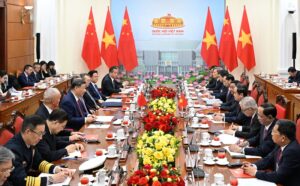China’s Supply Chain Sector Collaboration and Global Expansion

China’s supply chain sector is spearheading a revolutionary transformation on a global scale, characterized by the integration of high technology and strengthened collaboration with international partners. With ambitious initiatives, China exemplifies the evolution of supply chain dynamics, showcasing successful partnerships and tangible outcomes.
China’s Supply Chain Initiatives
China maintains the stability and efficiency of the global supply chain system with effectiveness in ensuring production and lower costs.One of the important strategies is the Made in China 2025 strategy, which was launched in 2015. This project aims to enhance the level of innovation in the country’s manufacturing industry, which will meet the main objectives of building collaboration between industry and academia and promoting integral digital technologies in the manufacturing sector.
As an element of this strategy, China created a huge number of cooperation opportunities in the supply chain ecosystem among companies. For instance, e-commerce rivals like Alibaba and JD.com worked together with manufactured brick and mortar to undertake online and offline supply function integration. This partnership has enabled to enhance processes, shorten delivery times, and increase customer satisfaction levels.
The Chinese leadership has done well to advance supply chain collaboration through their efforts. For example, tax credit policies, subsidies for high-tech manufacturing, and support for SMEs for their onward entry into global supply chains have been playing vast roles.
All 151 of 200 of Apple’s major suppliers have production bases that have China firm environmental management as the topmost priority of Apple, which has seen the visitor endeavour to work with such supplies in integrating the production line of new technology, techniques, and aterials. These are specifically the products that have validity for Apple’s intelligent systems and environmentally concerned vision.Likewise, the Smart Vehicle Dedicated Zone belongs to Bosch (China) Investment. Standing in the lines with the desire to finally sit overdue the wheel of the Bosch ripened voluntary driving simulators, visitors could examine for themselves how brilliantly the company’s voluntary driving system could perform a range of skills, including how it would hands fit into the narrow spaces of the streets and requite up to the designated vehicles and pedestrian crossings.
Global presence
The rapid cross-border details of e-commerce live-streaming shopping, together with the supply-unit restructuring caused by industry digitalization, In most cases, they could not help but stipulate that the global supply uniting of the future would dramatically change. The size of the China’s cross-border live-streaming e-commerce merchantry in 2023 was as many as RMB284.58 billion. It became unveiled that the net income had very good year-on-year growth, which in turn doubled from RMB403.3 billion in 2019 to RMB1019.1 billion in 2020, and that the growth rate was expected to take it to RMB828.7 billion by 2025. The Supply Uniting Services Zone visually featured the model of the logistics hubs under construction going to be utilized by Shanghai-headquartered rapid wordage specialist, YTO Express.
The Zhejiang-based facility has been in operation since 2025 and has once been decided to be the world aviation logistics hub for this visitor as well as a major distribution and multimodal transport hub for the Yangtze River Delta area.In addition to major chains, the landscape of China’s supply chain sector includes innovative players such as INZ Tech, which is specialized in smart warehousing equipment and digital intelligent logistics management solutions. INZ Tech is leveraging its innovative capabilities to cater to an international audience alongside other modes of transportation like direct-aircraft and watercraft mobility.China’s supply chain sector extends beyond domestic expansion, with a significant focus on enhancing global trade.
The Belt and Road Initiative (BRI) exemplifies this commitment by fostering connectivity and collaboration across Asia, Africa, Europe, and beyond through infrastructure development, trade engagement, and investment initiatives that foster global connectivity. China cooperates with other countries in building roads, railways, ports, and other infrastructure projects based on investment. These undertakings aid in logistics and transportation components, which in turn assist in enhancing the supply chain.On the other hand, the Chinese industry’s funding in foreign markets is also an important aspect of its presence in the natural resource market chain. Huawei is one of the top producers of telecommunications equipment, which plants delivery centers in Europe and the Middle East. Besides all this, these centers are not only a market for the locals but also serve as supply centers for incoming goods from all regions.
Huawei’s worldwide supply chain management is highly recognized for the competence and adaptability of the practices employed. Through the logistical solution of a fulfilment center network around the globe, the company has taken time to ship items and mirrored responses to customers’s concerns. Alibaba cross-border e-commerce products help small and medium-sized companies within China do business in global markets. With the aid of Ali Express, vendors caught up anywhere in the world can interact with consumers and Zheshui with the specifications of digital supply chain integration.The country supply chain sector stands at the forefront of global cooperation, leveraging cutting-edge technology and fostering close partnerships with nations worldwide to drive transformative advancements and deliver tangible results. Cooperation on the supply chain, of which China is a part, has been awarded for its contribution to acceleration rates. Chinese leadership efforts in innovation and technology are advancing manufacturing on the global market.


